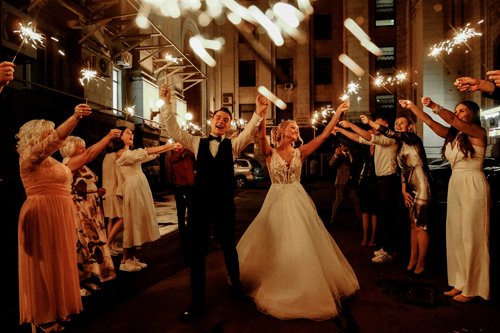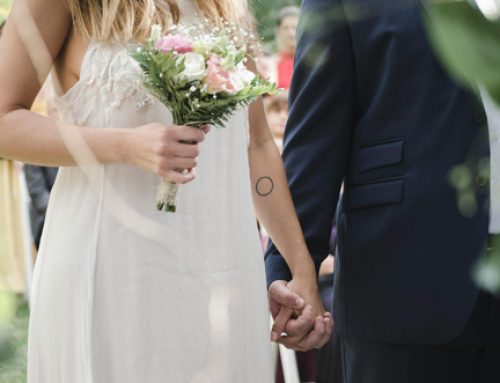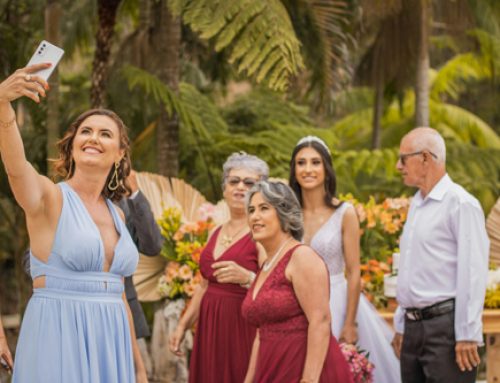A wedding day is a magical moment. However, it’s also a time when the behind-the-scenes details must be carefully planned. A big part of this is creating a well-crafted timeline that keeps the entire event on time and running smoothly. From the first look to the grand exit, a structured schedule can make the difference between a stressful day and an easy celebration.
How Long Is a Typical Wedding Timeline?
Including preparation activities, a typical wedding timeline can range from eight to 12 hours, though depending on various factors, this can vary significantly. First and foremost, the length of the timeline is often influenced by the locations of the ceremony and reception, the size and style of the wedding, and the specific events planned throughout the day.

A bigger wedding with more guests may need longer for activities like seating, serving meals, or transitioning between events. In contrast, a smaller wedding can have a more consolidated schedule, focusing on personal moments. Your preferences also impact the timeline as they differ on what should be included.
Ultimately, the timeline should reflect your vision for the special day, ensuring that every important moment is given the attention it deserves
Planning a Wedding Ceremony Timeline
A typical wedding ceremony can range from 20 minutes to an hour, depending on various factors such as cultural or religious traditions, personalized elements, and your preferences.
Below, we’ll explore all aspects of a wedding ceremony timeline and offer some questions to ask yourselves during the planning process.
Processional
The processional sets the tone for the wedding ceremony, marking the event’s official start. This part typically lasts five to 10 minutes, based on the number of people and aisle length. Consider the following:
- Who will be in the processional (parents, grandparents, bridal party)?
- What type of music will accompany the processional?
- How long will it take for everyone to walk down the aisle?
Consider incorporating meaningful songs or instrumental pieces to add a personal touch. For instance, many musicians offer custom mashups of songs with the traditional bridal entrance song, “Canon in D.”
Introduction
The officiant welcomes guests and sets the ceremony stage during the introduction, usually lasting two to five minutes. Questions to consider include:
- What tone do you want the officiant to set (formal, casual, humorous)?
- Will the officiant include any personal anecdotes about you as a couple?
- Should the officiant ask the guests to silence and put away their phones?
This last question is really about preference. Some couples prefer not to have photos and videos taken during the ceremony, while others may want a more relaxed atmosphere where guests can capture their own memories.
Readings
Readings are another meaningful touch, from spiritual and religious readings to personal anecdotes. You should consider:
- How many readings will there be, and who will read them?
- What type of readings do you want (religious, literary, personal)?
- How long will each reading take?
Similarly, you can choose to have songs or musical interludes between readings to add variety and emotion.
Officiant’s Address
The officiant’s speech is a key part of the ceremony, touching on marriage’s significance and the couple’s journey. This typically lasts five to 10 minutes. Finding the right officiant is key, so here are a few questions to answer:
- What type of ceremony do you want (secular, religious, spiritual)?
- Do you have a preferred officiant, or are you open to recommendations (friend or family member, professional officiant)?
- Will the officiant work with you to personalize the address?
Some officiants may have specific guidelines or restrictions on what can be included in their addresses, so it’s important to discuss expectations beforehand.
Vows
Exchanging vows is the ceremony’s most personal and deeply emotional moment. These are typically relatively short, around five minutes, but can often linger on to 10 minutes. Questions to reflect on include:
- Will you write your own vows or use traditional ones?
- How long will each person’s vows be?
- Do you need time to rehearse your vows?
The officiant should also vet the vows to ensure you’re comfortable with what they’ll be saying and aware of how long they’ll be.
Ring Exchange
The ring exchange is a fun, intimate part of the ceremony that usually takes about three to five minutes. When planning this part, consider:
- What types of rings are you exchanging (Tungsten, gold, custom designs)?
- Will you include any specific words or promises during the exchange?
- Do you need to practice putting the rings on each other?
Traditionally, the best man holds each wedding band and presents them to the couple during this part.
Closing Remarks
The closing remarks are the officiant’s final words, offering blessings or well wishes to the couple. This typically takes about one to two minutes. For this part, consider:
- What kind of closing do you want (traditional blessing, personal message)?
- Will the officiant include any announcements (such as reception details)?
This part can also include a moment of silence or a final song before the recessional begins.
Recessional
The recessional is the joyous conclusion as the couple exits the venue, usually lasting five to 10 minutes. When planning this, think about:
- What music will play during the recessional?
- Will there be a specific order for the bridal party to exit?
- Are there any special exit traditions you want to incorporate (flower petals, rice)?
This part moves fairly quickly, so it’s essential to have a clear plan. Also, consider discussing with the photographer beforehand if there are any particular moments to capture during this time.
Planning a Wedding Reception Timeline
A wedding reception is packed with indelible moments and cherished traditions. Here are some key events you’ll usually find in a wedding reception timeline:
- Grand entrance: The formal introduction of the newlyweds and, sometimes, the entire wedding party;
- First dance: Your first dance as a married couple;
- Dinner service: The serving of the meal, whether it’s a plated dinner, buffet, or family-style;
- Speeches and toasts: Heartfelt speeches from wedding party members, and possibly family members or friends;
- Family dances: A lovely dance moment with the newlyweds and their parents;
- Cake cutting: The ceremonial cutting of the wedding cake;
- Bouquet and garter toss: Traditional activities where the bride tosses their bouquet, and the groom tosses the garter;
- Grand exit: The final farewell, often accompanied by a special send-off.
This is just a general overview, as you can personalize the reception timeline to reflect your preferences and traditions.
First Dance
The first dance symbolizes your new life together. It follows the grand entrance and typically lasts three to five minutes.
When planning the first dance, consider:
- What song will you choose for your first dance?
- Will you take dance lessons or choreograph a routine?
- When will the first dance take place in the timeline?
For the song choice, ensure it’s meaningful to both of you and reflects your relationship.
Cake Cutting
The cake-cutting tradition typically occurs after dinner and lasts about 10 to 15 minutes. When planning the cake-cutting, think about:
- How will the cake be served to guests afterward?
- Do you want to include any unique traditions, such as feeding each other cake?
- Will the cake be a traditional tiered cake, or will you opt for a unique dessert option?
You may also choose a separate dessert table or offer alternative options for those with dietary restrictions.
Dinner Service
Dinner service is crucial at the reception, allowing guests to eat and mingle. Depending on the service style, it typically lasts 60 to 90 minutes. Consider the following questions:
- How will dinner be served (plated, buffet, family-style)?
- What time will dinner be served, and when will it end?
- Will there be any special dietary considerations for guests?
Dinner isn’t rushed, so planning enough time for guests to enjoy their meals and conversation is essential.
Speeches and Toasts
Speeches and toasts are emotional moments during which friends and family express love and best wishes for you as a newlywed couple. They usually last 20 to 30 minutes.
When planning speeches and toasts, consider:
- Who will be making speeches (wedding party, parents)?
- When will the speeches take place?
- How long will each speech last?
Before the big day, have a trusted friend or family member vet each speech to ensure it’s appropriate and within the allotted time frame.
Grand Exit
The grand exit is your final farewell, often marked by a celebratory send-off such as sparklers, bubbles, or confetti. This event usually lasts 10 to 15 minutes at the reception’s end. When planning the grand exit, think about:
- What type of send-off do you want?
- When will the grand exit take place?
- How will guests participate in the send-off?
Have fun and be creative with your send-off! Just confirm with the venue for any exit materials or timing constraints.
With a little forethought, help from a wedding planner, and coordination with your vendors, you can create a timeline that flows smoothly and highlights the moments you want to remember forever.




Leave A Comment